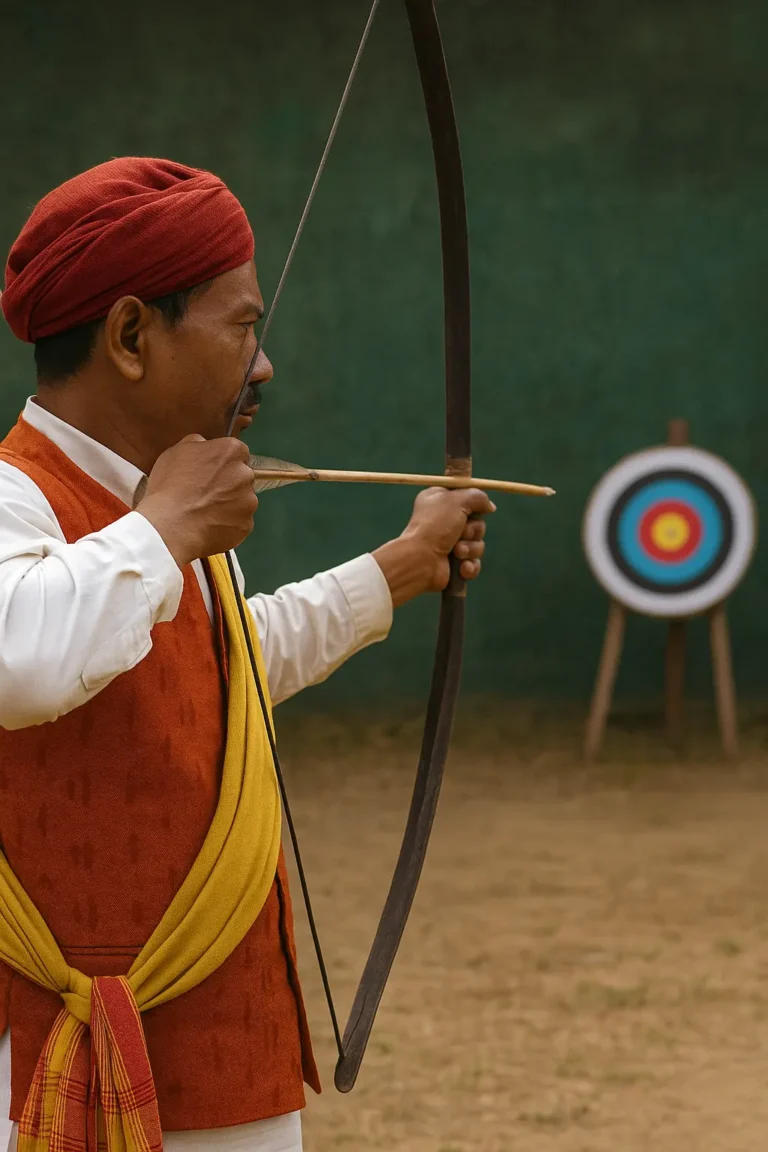How Shillong Teer Works: From Archery to Number Results
Shillong Teer isn’t just another number-based game — it’s a cultural blend of traditional archery and mathematical curiosity that has captured the attention of locals and Teer enthusiasts across India. Held in the lush hills of Meghalaya, this unique practice sees trained archers shoot arrows at a target while players predict the final two-digit result based on the total hits.
But how does it all actually work? From the rhythm of the arrows in Shillong’s Polo Ground to the logic behind the winning numbers, this article breaks down every step of the process — in simple terms anyone can understand.
Whether you’re new to Teer or looking to deepen your understanding of the game’s flow, this guide will walk you through how Shillong Teer operates from start to finish — archery to number result.
🔵 The Daily Game Setup – Behind the Scenes
While many see only the final numbers posted in newspapers or online, Shillong Teer is built on a carefully managed process that begins hours earlier each day.
🏹 Where & When It Happens
Shillong Teer is hosted at the Polo Ground in Shillong, the capital of Meghalaya. The game is played six days a week — Monday to Saturday — and typically begins in the afternoon. Two rounds of archery take place at:
- 3:45 PM for the First Round
- 4:45 PM for the Second Round
The setup begins much earlier, though. Archers, organizers, and ticket sellers arrive by mid-morning to prepare the venue, verify bows and arrows, and set up targets according to regulation standards.
🎯 Who Organizes the Game?
The Khasi Hills Archery Sports Association (KHASA) oversees the entire event. This organization ensures that every round is conducted fairly, with licensed archers and regulated procedures. From checking the safety of the arrows to assigning verified archers, KHASA maintains cultural dignity while keeping things official.
🏹 The Archery Zone & Safety Measures
The actual archery ground is carefully structured:
- A cylindrical bamboo target is placed at a fixed distance.
- 50 archers line up with strict spacing to ensure safety.
- Only official personnel are allowed near the target zone.
All archers are trained and experienced, and many have been part of the tradition for years — even decades. Spectators are usually kept behind safe boundaries but often gather to watch the shots and count arrows silently.
🎯 The Two Rounds of Shooting
Shillong Teer is structured around two timed rounds of archery, each contributing one of the two final numbers that make up the day’s Teer result. The structure is simple yet precise, and it reflects a balance of skill, tradition, and controlled randomness.
🔸 First Round: 3:45 PM
- Around 50 skilled archers gather on the field.
- Each archer shoots 30 arrows toward a small cylindrical target made of tightly bundled bamboo.
- The arrows are fired rapidly within a short time window, usually 4 to 5 minutes.
- After all arrows are shot, officials count the total number of arrows that successfully hit the target.
- The last two digits of that total become the first round result.
Example:
If 1,095 arrows hit the target → First Round Result = 95
🔸 Second Round: 4:45 PM
- The same group of archers return to shoot 20 arrows each.
- The setup remains identical, and the countdown process is repeated.
- Again, the total arrows that hit the target are counted, and the last two digits become the second round result.
Example:
If 1,046 arrows hit → Second Round Result = 46
The combined format usually looks like this: 📝 Teer Result: 95 | 46
🎯 Precision and Supervision
These rounds are closely monitored by officials from the Khasi Hills Archery Sports Association (KHASA). The target and surrounding setup are verified beforehand, and counting is conducted manually in the presence of observers to ensure transparency.

🔢 How Results Are Calculated
At the heart of Shillong Teer is a simple but fascinating number system — rooted in precision counting. Unlike computer-generated results or randomized draws, Shillong Teer numbers are derived directly from physical actions: the arrows that hit the target.
📌 Step-by-Step Result Calculation
- Archers shoot arrows during the first and second rounds.
- Officials count how many arrows successfully hit the target.
- Only the last two digits of the total number of hits are considered.
- These two-digit numbers form the official Teer results for each round.
🧮 Example 1:
- 1,091 arrows hit in first round → Result: 91
- 1,064 arrows hit in second round → Result: 64
- Final Display: 91 | 64
🧮 Example 2:
- 1,010 hits → Result: 10
- 1,005 hits → Result: 05
👉 Even if the number is below 10 (like 6), it’s shown as 06 to keep the two-digit format.
📈 Why Two Digits?
The use of two-digit results (00–99) ensures:
- Easy-to-understand results for players
- A structured prediction system
- Uniform betting slips and display formats
This method is transparent, easily observable, and understood by both officials and participants alike — a reason why the system has stood the test of time.
🎟️ Number Ticketing System & Player Side
While the archers determine the results, the public participates through a unique and well-structured number ticketing system. This is how players engage with the game — by predicting the outcome of the arrow hits using two-digit numbers ranging from 00 to 99.
🧾 How Numbers Are Chosen
- Each player selects one or more two-digit numbers they believe will be the result of either round.
- Some players use dream interpretations, others rely on patterns or predictions.
- Numbers can be picked for the first round, second round, or both.
💡 Common example: A player chooses 47 for the first round. If the result is 47, the player wins based on the odds associated with that choice.
🏪 Where Tickets Are Bought
- Tickets are sold only at authorized Teer counters licensed by the Meghalaya government.
- Sales begin at 10:00 AM and close at 3:30 PM, just before the first round.
- Tickets are usually physical slips with the number and bet amount clearly printed.
📋 Ticket Example:
Counter ID: 014
Number: 56
Bet Amount: ₹20
Date: 23-Apr-2025
Round: First
💸 Payouts & Winnings
Payouts vary depending on:
- Bet amount
- Round (first or second)
- Local counter’s rate (usually based on odds like 1:80 or 1:60)
For example, betting ₹10 on a number and hitting it in the first round could return ₹800 based on a 1:80 payout rate.
⚠️ Note: Only licensed counters are permitted to issue and settle tickets.
📢 The Result Announcement & Where to Check
Once both rounds of archery are complete and the arrow hits are counted, the next question for every player is — where and how can I check the Shillong Teer result?
The result announcement process is quick, public, and transparent — another reason why the game has retained so much trust among locals.
🕓 When Are Results Declared?
- First Round Result: Around 4:15 PM
- Second Round Result: Around 5:15 PM
Results are declared soon after arrow counts are verified, typically within 15–20 minutes of each round’s conclusion.
📍 Where Are Results Announced?
- Official Teer Counters:
- Printed result boards are updated manually and displayed in public.
- This remains the most trusted method in Shillong and nearby areas.
- Radio & Word-of-Mouth:
- Local radio stations and community networks often announce results for those without internet.
- Online Platforms:
- Digital platforms like shillong-teer-results.com publish updated results daily.
- Online viewers can check both first and second round outcomes, sometimes with archive access.
- Mobile Apps & Telegram Channels:
- Many apps and local Telegram groups also circulate the results, but it’s best to verify with an official counter or a trusted site.
📝 Example Result Display:
Date: 23-Apr-2025
First Round: 57
Second Round: 84
🧭 Reading the Result Format
- Results are always shown in the two-digit format
- Written as: 57 | 84
Where:- 57 = Result of First Round
- 84 = Result of Second Round
🧠 The Role of Skill vs Luck in Shillong Teer
Shillong Teer stands apart from typical number games because it involves real-world skill — not just chance. This unique blend of physical precision and intuitive prediction makes Teer fascinating to participants and observers alike.
🎯 Skill of the Archers
The most crucial part of the game relies on the accuracy and consistency of the archers. These are not casual players — most are part of local archery clubs and undergo rigorous training.
- Target placement and arrow delivery follow specific traditional norms.
- Arrows are released quickly, and hitting a small bamboo target from distance demands focus, balance, and rhythm.
- Even minor changes in wind or stance can affect the hit count — which in turn alters the day’s number result.
This adds a real performance element, which distinguishes Shillong Teer from randomized number games or draws.
🔢 Prediction and Community Logic
On the player’s side, the game appears to involve luck — but there’s more beneath the surface:
- Locals often rely on dream interpretations to pick numbers (called Teer dream numbers).
- Some follow historical patterns, past result frequency, or even community charts.
- Predicting both rounds correctly is extremely rare, but guessing one round can be common among regulars.
So, while it’s partly based on chance, many long-time participants believe in patterns, charts, and subconscious intuition — creating a semi-structured approach to number selection.
🧭 Tradition Meets Game Psychology
Shillong Teer isn’t designed for guaranteed wins — and that’s part of its charm. It keeps players:
- Curious about how archery will play out
- Engaged in logic and number analysis
- Respectful of the traditional, non-mechanized nature of the outcome
❓ FAQs – Understanding How Teer Works
Even though Shillong Teer is a cultural mainstay in Meghalaya, many people — especially visitors or new players — have questions about how it really functions. Here are some of the most frequently asked questions, answered in a clear and beginner-friendly way.
Q1: Can I visit the Shillong Teer ground and watch the game?
A: Yes, the public can observe the game from safe, designated areas near the Polo Ground in Shillong. However, the archery zone itself is restricted to ensure safety and fair play.
Q2: Who verifies the number of arrows that hit the target?
A: Officials from the Khasi Hills Archery Sports Association (KHASA) are responsible for counting hits in both rounds. These counts are double-verified before results are announced.
Q3: How is fairness ensured in Shillong Teer?
A: The game is regulated under the Meghalaya Amusements and Betting Tax Act and the 2018 regulation act. Archers, ticket counters, and result processes are all monitored and licensed.
Q4: What happens if an arrow misses the target?
A: Missed arrows are not counted. Only arrows that successfully hit the target are tallied, and only their final count influences the two-digit result.
Q5: Can I play Shillong Teer online?
A: No. Currently, tickets must be purchased physically at licensed counters within Meghalaya. Online result checking is allowed, but online betting is not legal or recognized.
Q6: How do people choose numbers to play?
A: Many use personal logic, historical charts, or dream-based number interpretations. It’s a mix of cultural belief and pattern analysis, unique to Teer’s heritage.
🏁 Final Thoughts – Tradition in Action
Shillong Teer is more than just a number game — it’s a living tradition where archery, community, intuition, and cultural pride come together each afternoon in the hills of Meghalaya.
From the careful setup of archers at Polo Ground to the moment numbers appear on chalkboards and websites, every part of Teer reflects a blend of discipline and local spirit. Whether you’re a visitor curious about how it works or someone looking to play for the first time, understanding the process — from arrows to results — is key to truly appreciating this unique game.
✅ It’s regulated, not random.
✅ It’s skill-based, not tech-generated.
✅ And most importantly — it’s rooted in people, not platforms.


